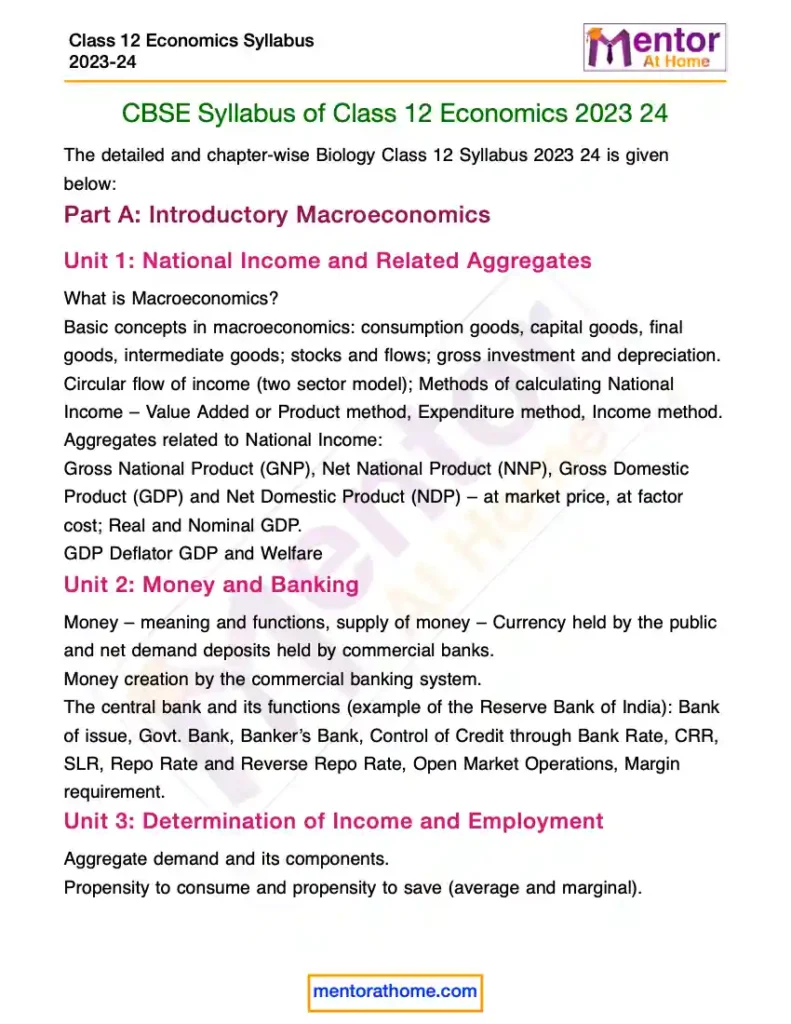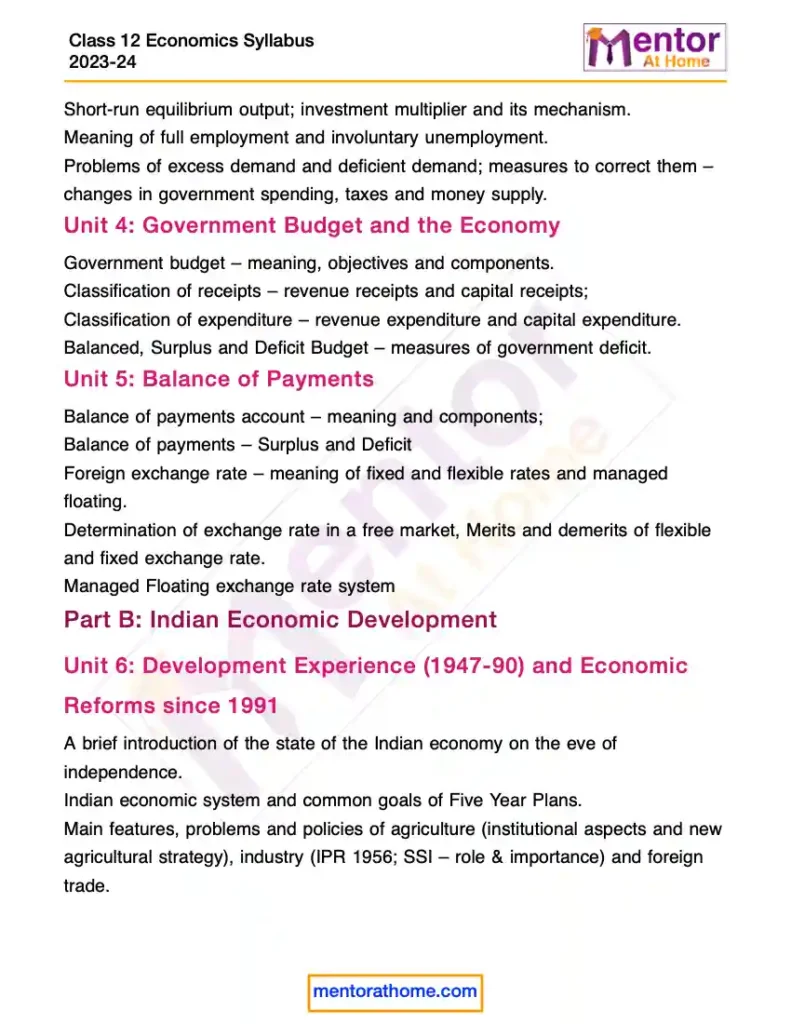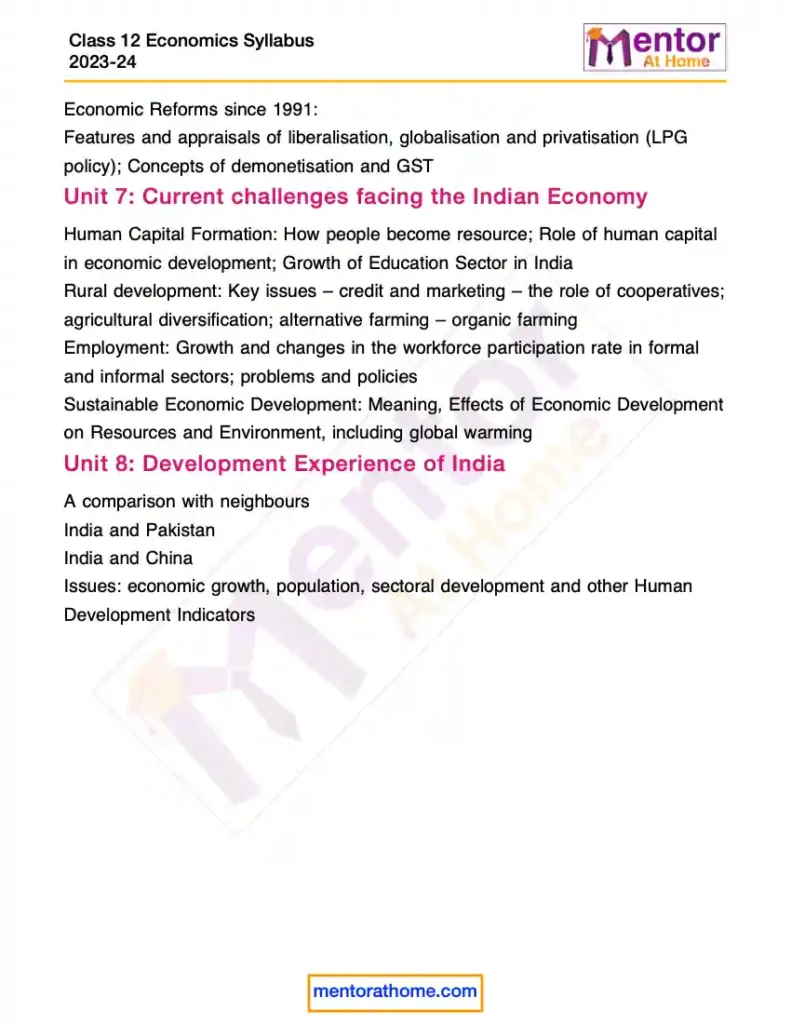Class 12th Economics Syllabus 2023-24
Here we provide the latest CBSE Class 12 Economics Syllabus 2023 24. You can also Download the new and revised CBSE Class 12 Economics syllabus PDF. The present revised syllabus of class 12 Economics has been designed in accordance with National Curriculum Framework 2005.
Economics is a scoring subject but needs a lot of practice and conceptual understanding of the topics. CBSE Economics syllabus class 12 helps you understand the important topics. We advise you to read the CBSE class 12 Economics syllabus 2022 23 carefully. Class 12th Economics syllabus also helps you in preparation for competitive exams like UPSC, SSC, Banking etc.
You may also like
- Class 12 NCERT Solution
- Class 12 NCERT Books
- Class 12 NCERT Notes
- Class 12 Syllabus for all Subjects
CBSE Class 12 Economics Syllabus 2023-24 Pdf
Click here to download Class 12th Economics Syllabus Pdf
CBSE Syllabus of Class 12 Economics 2023 24
The detailed and chapter-wise Biology Class 12 Syllabus 2023 24 is given below:
Part A: Introductory Macroeconomics
Unit 1: National Income and Related Aggregates
What is Macroeconomics?
Basic concepts in macroeconomics: consumption goods, capital goods, final goods, intermediate goods; stocks and flows; gross investment and depreciation.
Circular flow of income (two sector model); Methods of calculating National Income – Value Added or Product method, Expenditure method, Income method.
Aggregates related to National Income:
Gross National Product (GNP), Net National Product (NNP), Gross Domestic Product (GDP) and Net Domestic Product (NDP) – at market price, at factor cost; Real and Nominal GDP.
GDP Deflator GDP and Welfare
Unit 2: Money and Banking
Money – meaning and functions, supply of money – Currency held by the public and net demand deposits held by commercial banks.
Money creation by the commercial banking system.
The central bank and its functions (example of the Reserve Bank of India): Bank of issue, Govt. Bank, Banker’s Bank, Control of Credit through Bank Rate, CRR, SLR, Repo Rate and Reverse Repo Rate, Open Market Operations, Margin requirement.
Unit 3: Determination of Income and Employment
Aggregate demand and its components.
Propensity to consume and propensity to save (average and marginal).
Short-run equilibrium output; investment multiplier and its mechanism.
Meaning of full employment and involuntary unemployment.
Problems of excess demand and deficient demand; measures to correct them – changes in government spending, taxes and money supply.
Unit 4: Government Budget and the Economy
Government budget – meaning, objectives and components.
Classification of receipts – revenue receipts and capital receipts;
Classification of expenditure – revenue expenditure and capital expenditure.
Balanced, Surplus and Deficit Budget – measures of government deficit.
Unit 5: Balance of Payments
Balance of payments account – meaning and components;
Balance of payments – Surplus and Deficit
Foreign exchange rate – meaning of fixed and flexible rates and managed floating.
Determination of exchange rate in a free market, Merits and demerits of flexible and fixed exchange rate.
Managed Floating exchange rate system
Part B: Indian Economic Development
Unit 6: Development Experience (1947-90) and Economic Reforms since 1991
A brief introduction of the state of the Indian economy on the eve of independence.
Indian economic system and common goals of Five Year Plans.
Main features, problems and policies of agriculture (institutional aspects and new agricultural strategy), industry (IPR 1956; SSI – role & importance) and foreign trade.
Economic Reforms since 1991:
Features and appraisals of liberalisation, globalisation and privatisation (LPG policy); Concepts of demonetization and GST
Unit 7: Current challenges facing the Indian Economy
Human Capital Formation: How people become resource; Role of human capital in economic development; Growth of Education Sector in India
Rural development: Key issues – credit and marketing – the role of cooperatives; agricultural diversification; alternative farming – organic farming
Employment: Growth and changes in the workforce participation rate in formal and informal sectors; problems and policies
Sustainable Economic Development: Meaning, Effects of Economic Development on Resources and Environment, including global warming
Unit 8: Development Experience of India
A comparison with neighbours
India and Pakistan
India and China
Issues: economic growth, population, sectoral development and other Human Development Indicators
CBSE Class 12 Economics Syllabus 2023- 24 – Course Structure
Before you read the Class 12th Economics syllabus you have to understand the course structure to complete the CBSE Syllabus for Class 12 Economics 2023-24.
| Units | Marks | Periods | |
| Part A | Introductory Macroeconomics | ||
| National Income and Related Aggregates | 10 | 30 | |
| Money and Banking | 06 | 15 | |
| Determination of Income and Employment | 12 | 30 | |
| Government Budget and the Economy | 06 | 17 | |
| Balance of Payments | 06 | 18 | |
| 40 | |||
| Part B | Indian Economic Development | ||
| Development Experience (1947-90) and Economic Reforms since 1991 | 12 | 28 | |
| Current Challenges facing Indian Economy | 20 | 50 | |
| Development Experience of India – A Comparison with Neighbours | 08 | 12 | |
| 40 | |||
| Theory Paper (40+40 = 80 Marks) | 200 | ||
| Part C | Project Work | 20 | 20 |
Prescribed Books to Cover Class 12th Economics Syllabus:
- Statistics for Economics, NCERT
- Indian Economic Development, NCERT
- Introductory Microeconomics, NCERT
- Macroeconomics, NCERT
- Supplementary Reading Material in Economics, CBSE


